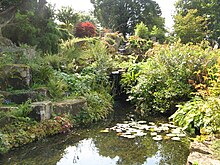


A rock garden, also known as a rockery and formerly as a rockwork, is a garden, or more often a part of a garden, with a landscaping framework of rocks, stones, and gravel, with planting appropriate to this setting. Usually these are small Alpine plants that need relatively little soil or water. Western rock gardens are often divided into alpine gardens, scree gardens on looser, smaller stones, and other rock gardens.[1]
Some rock gardens are planted around natural outcrops of rock, perhaps with some artificial landscaping, but most are entirely artificial, with both rocks and plants brought in. Some are designed and built to look like natural outcrops of bedrock. Stones are aligned to suggest a bedding plane, and plants are often used to conceal the joints between said stones. This type of rockery was popular in Victorian times and usually created by professional landscape architects. The same approach is sometimes used in commercial or modern-campus landscaping but can also be applied in smaller private gardens.
The Japanese rock garden, or dry garden, often referred to as a "Zen garden", is a special kind of rock garden with a few large rocks, and gravel over most of the surface, often raked in patterns, and no or very few plants. Other Chinese and Japanese gardens use rocks, singly or in groups, with more plants, and often set in grass, or next to flowing water.
Until the fairly recent past the removal for gardening purposes of both plants and stone from their natural wild locations has resulted in considerable problems, and many are now legally protected; English Westmorland limestone pavement is one example.[2]